Electric Patio Heaters: Best Electric Patio Heater in 2023 (Reviews + Buying Guide)
Nothing says cosy quite like an electric patio heater. Whereas gas-powered patio heaters are designed for outdoor entertainment, electric patio heaters have a level of versatility that makes them suitable for both the indoors and outdoors.
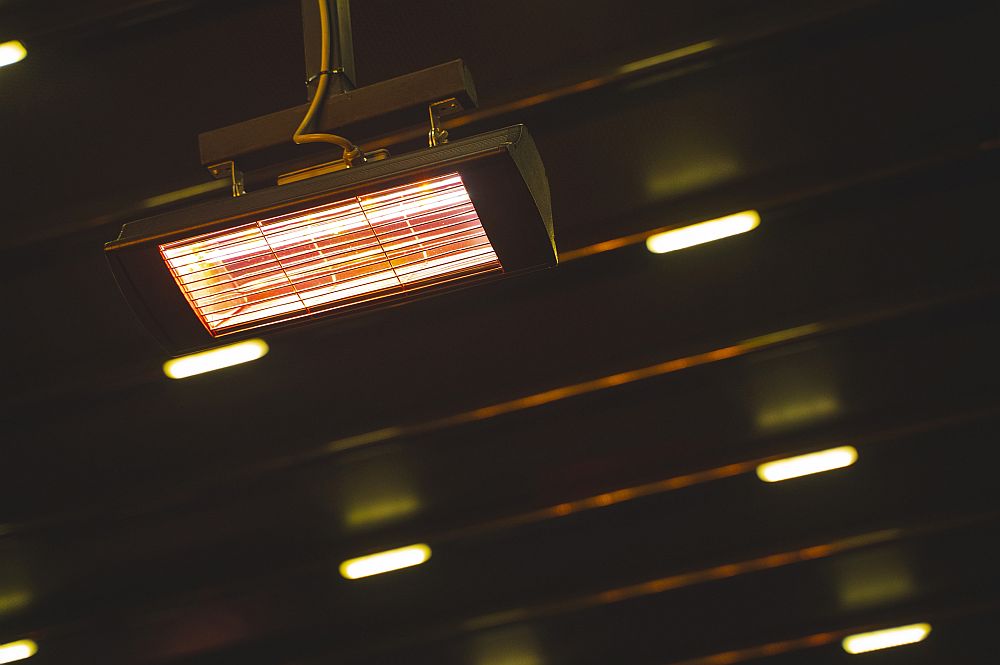
Wondering which kind of patio heater is best for you? Don’t worry, we’ve got your back.
In this article, we will go through an eclectic assortment of electric patio heaters, including a list of the pros and cons of each model and their best features, so you can make an informed buying decision.
Don’t have time to read? Here is our list of the best electric patio heaters in the UK (There’s one for every price range):
-
WestWood Garden Outdoor Quartz 2KW Patio Heater
-
Oypla Electrical 2kW Quartz Freestanding Patio Heater
-
Futura Deluxe Wall-Mounted Electric Heater
-
Heatlab Freestanding Electric Patio Heater
-
Costway Wall-Mounted Infrared Patio Heater with Remote Control
-
Sundate Electric Wall-Mounted Infrared Heater (2000 W)
-
Blumfeldt Rising Sun Mono Infrared Radiant Heater (2500 W)
-
KIASA – 1500 W Ceiling Patio Heater
-
Swan Al Fresco Column Electric Patio Heater
-
Firefly Table-top Electric Patio Heater
What are the best electric patio heaters in the UK?
As with gas-powered patio heaters, there are a number of factors you should consider when choosing an electric patio heater. One thing to consider is appearance. As mentioned above, slim electric heaters tend to be lower in output than their gas-powered counterparts, so keep this fact in mind when making your selection.
Of course, form should (usually) follow function, also pay attention to how much space a given patio heater can warm. If you’re not 100% sure what you need, stick around until the end of the article, where we tackle this and other common questions about patio heaters.
Here are the 8 best electric patio heaters in the UK (including infrared).
1. WestWood Garden Outdoor Quartz 2kW Patio Heater
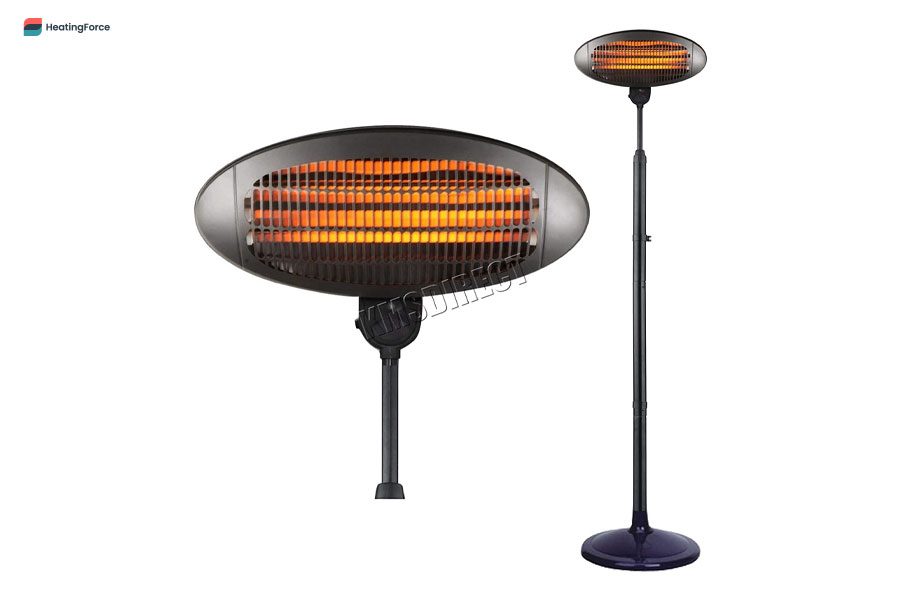
The WestWood Garden Outdoor Quartz 2KW Electric Patio Heater gives off a retro vibe that we really like. Adjustable and freestanding, this outdoor steel-framed heater is of excellent value. Perfect for a garage or other indoor setting, WestWood has really nailed the classic ‘60s-style aesthetic.
It’s capable of outputting heat at 650W, 1350W, and 2000W, and our tests showed that the WestWood has enough oomph to fill a 4m x4m patio with nourishing warmth. This means you should have no issues warming rooms up to 15 metres squared — but, of course, you’ll get more heat in an enclosed or semi-enclosed setting than in one that’s fully open to the elements.
Now, we will admit this heater isn’t perfect. We were quite frustrated with the lamentably short, 2-metre power lead, but this can easily be remedied with an extension lead (if need be). As such, this should only be a minor inconvenience for most people.
Who should buy this patio heater?
If you’re looking for something that looks stylish, won’t break the bank, and will deliver the heat you so sorely desire, it’s honestly pretty tough to look past this excellent outdoor heater from WestWood. We think this unit will be particularly useful for anyone who’d like to customise their patio heater. The temperature, height, and angle have a large amount of adjustability, which is really everything in terms of features that you can ask for (and more) in a budget heater.
One final note is that this heater does not ship with a cover, so you may want to look into investing in one unless you plan on storing it inside when it’s not in use.
Pros of this patio heater:
- Affordable and great value
- Retro metal design
- Highly adjustable configuration
Cons of this patio heater:
- Short extension lead (although it can be fixed with an extension cord)
- Doesn’t ship with a cover
2. Oypla Electrical 2kW Quartz Freestanding Patio Heater
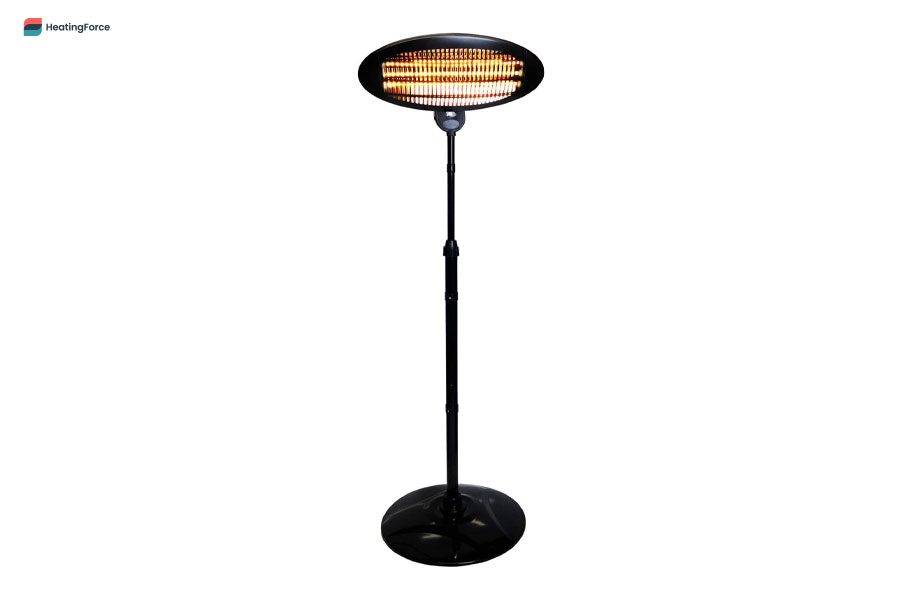
The Oypla Electrical 2kW Quartz freestanding outdoor electric garden patio heater has a very similar design to the first heater on this list. While testing the device, we noticed that it shares many of the same features, too, including adjustable heat and height.
And, like the WestWood Garden Outdoor Quartz 2 kW Electric Patio Heater, we were happy to see that Oypla has included overheating protection to ensure the safety of the product and its customers.
That said, Oypla has gone for a more practical approach here, giving this particular model a larger base for added stability.
Conveniently, Oypla offers free postage for UK residents, which is always welcome news. The heater is CE/GS Certified & ROHS Certified and weighs in at a shade under 9 kg.
One other thing to mention is that we found the setup with this model wasn’t as easy as the WestWood heater.
Who should buy this patio heater?
This heater is suitable for home or commercial use. There is a lamp life of 5,000 hours, including a 2,000 W quartz tube heating element. The item is splash-resistant with a IPX4 rating, but the manufacturers strongly advise against using it during rain. If you’re tossing up between this heater and the WestWood Garden Outdoor Quartz, our advice would simply be to pick the one you think looks best — that’s how similar they are in all other regards.
Pros of this patio heater:
- Affordable and great value
- Retro metal design
- Highly adjustable configuration
- A 4.5-star rating from 240+ Amazon reviews
Cons of this patio heater:
- Short extension lead (although it can be fixed with an extension cord)
- Doesn’t ship with a cover
- Setup might be a little bit annoying for some people, although it’s not exceptionally hard to figure out
- Heat isn’t anything to write home about, but it will work great for people who are close to the unit itself
3. Futura Deluxe Wall-Mounted Electric Patio Heater
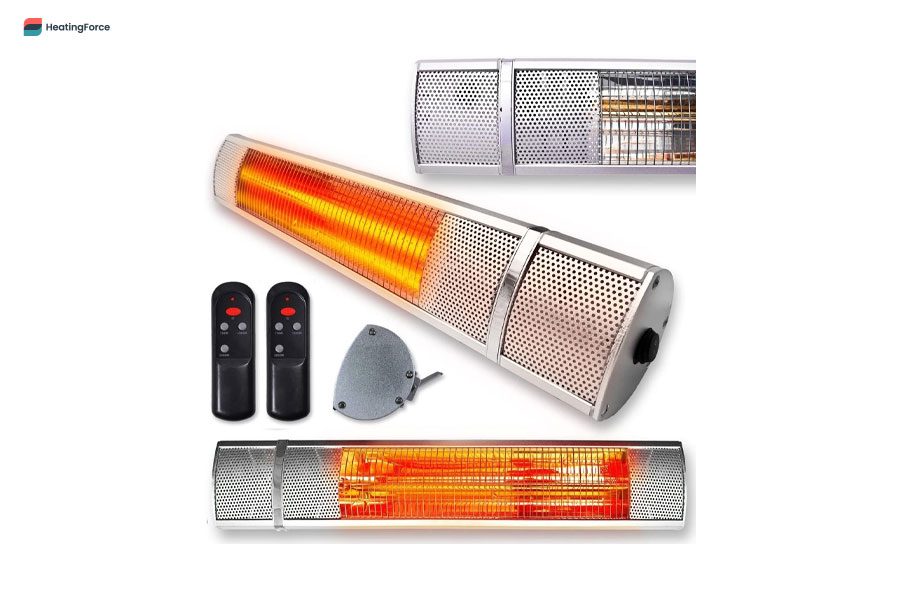
Now let us show you something completely different: the Futura Deluxe Wall-Mounted Electric Heater. This infrared heater is wall-mounted, with a distinct prism-like design and robust construction.
While testing the Futura, we found that it comes with 3 different heat settings, the highest of which is 2,000W — typical for domestic electric heaters.
What we really liked was that Futura thoughtfully included 2 remote controls for this electric heater, which is especially useful since you’re mounting this unit to the wall. It will also be handy if you happen to lose one! These kinds of small features can make all the difference difference.
One other thing that we really want to mention is something we found in the consumer reviews — the superior level of customer care from Futura. In one example, a customer reported a very rare, technical fault with their electric heater, causing it to stop working. In response, Futura offered a refund, or a free replacement. The customer opted for the latter, receiving a new heater in just 2 days! We think that’s impressive and something that all companies should aim for.
We were also glad to see that Futura has included a 2-year warranty with this heater.
Who Should Buy This Patio Heater?
There’s really no end to the amount of places where this heater will be useful — restaurants, bars, terraces, balconies, workshops, patios, gazebos, decking, summer houses, garages, workshops and many more other places, such as your garden or backyard.
It will cost you roughly 20p per hour to run, and the adjustable angle is a nice addition. It’s strong enough to heat a room up to 20 metres squared, so you should bear those dimensions in mind when making your decision.
Pros of this patio heater:
- Ships at a weight of only 3 kg
- Great for many different outdoor scenarios
- Variable power output
- Excellent customer care and warranty
Cons of this patio heater:
- A bit more expensive than some of the other heaters, although you definitely get what you pay for!
4. Heatlab Electric Patio Heater, Free Standing
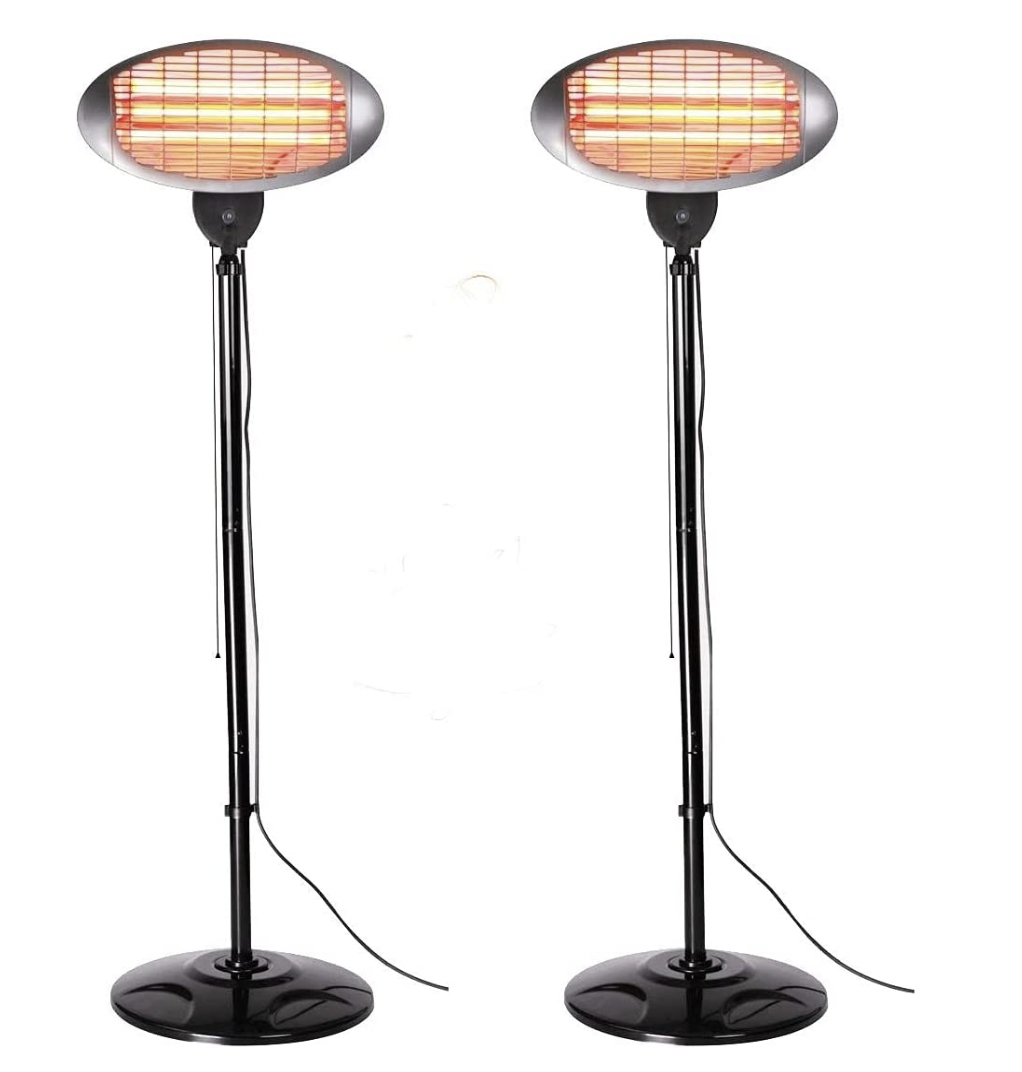
Next on our list of the best electric patio heaters in the UK are these twins from Heatlab. That’s right: you actually get a set of 2 with your purchase. For a very reasonable price, too — just over 100 quid for both, at the time of writing.
While testing these heaters, we were quite impressed with the ease of operation and the quick, gentle heat they produced.
Controls are as simple as pulling on a string to turn the device off or choose one of the 3 heat settings — 650W, 1,350W, and 2,000W. Using the maximum setting, we could heat a 4m x 4m outdoor patio without issues on a cool September evening. Mind you, these electric patio heaters will still suffice on chillier nights — but you’ll have to layer up.
One downside we’ll have to report here is the lack of assembly instructions. That said, the assembly is fairly basic, so you shouldn’t have too much trouble.
Another, minor drawback is the lack of remote control, although the pull string is still a good alternative to fumbling around with a knob.
Who should buy this patio heater?
This electric patio heater from Heatlab is a splendid match for anyone who needs 2 heaters to warm up a space evenly — without scalding those nearest and freezing those farthest away — from 2 different angles. You’ll find that the heaters’ adjustable height and head make it even easier to focus warmth the way you want it.
Another thing you might find handy is the portability — we thought this pair of heaters was super-simple to move around given their lightweight. However, we were still happy to discover a relatively heavy base, meaning the heaters wouldn’t topple over at the first gust of strong wind. (Another key safety feature is the IPX4 certification, which means these heaters are splash-resistant).
Pros of this patio heater
- Comes in a set of 2
- Easy control with a pull string
- Adjustable head angle and height
- Instant, powerful, but even heat
- Overall light weight, but the base is heavy enough to prevent toppling
- IPX4-rated — splash-resistant
Cons of this patio heater
- No remote control
- Assembly instructions not included
- Some buyers report changing the screws to their own, as the ones supplied with the purchase are low-quality
5. Costway Wall-Mounted Infrared Patio Heater with Remote Control
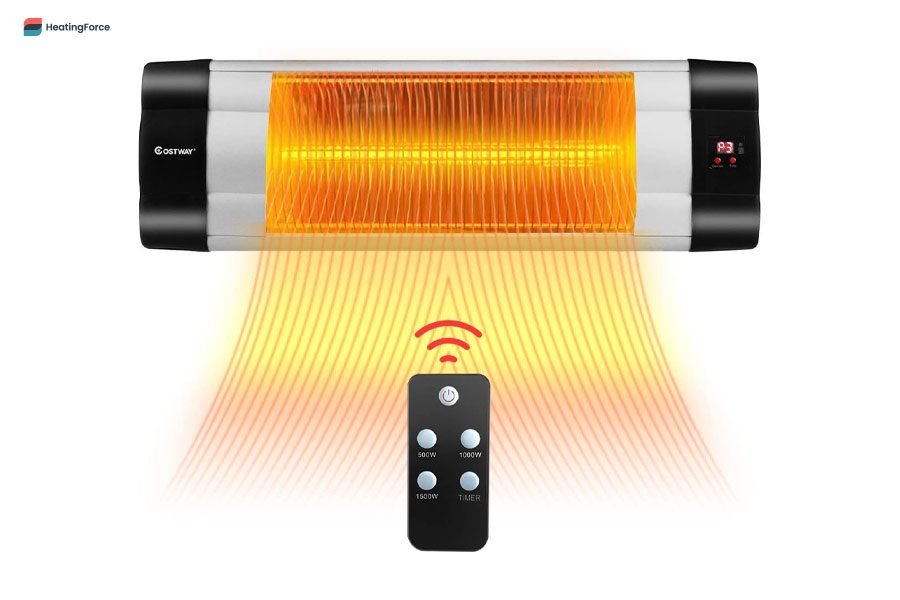
The Costway Wall-Mounted Infrared Patio Heater with Remote Control has been receiving rave reviews, and our tests showed us why! The benefits are obvious. There’s the aluminium alloy housing that gives this heater a durable exterior. Then, the infrared heating element that’s built to ensure even heat. Finally, the splash-proof rating, which makes this heater suitable for outdoor use.
You’ll find that there are 3 heating modes available, ranging from 500 W to 1,500 W, with the latter being sufficient for cooler evenings. We were also impressed with the 24-hour timer, which gives you break from having to control the unit by hand. (That said, like any other heater, this is not a set-it-and-forget-it device).
Since it’s wall-mounted, we were happy to find a remote control in the package; we had no problems using it to operate the heater.
One thing worth mentioning is that the manufacturer claims a service life of up to 4,000 hours. We couldn’t verify this claim, but if true, it would translate into a lifespan of 500 days if you leave the heater on for 8 hours each day.
Who should buy this infrared patio heater?
This is another all-rounder electric heater that Costway can be really proud of. If you appreciate features like automatic timing, you will find the 24-hour timer to be particularly useful. If you’re looking for a new electric heater for the office, lounge, bedroom, or patio, this Costway heater will surely serve you well.
Pros of this patio heater:
- Rapid heating
- Can be mounted on your wall
- Suitable for inside or outside use
- Waterproof
- Stable heat
- 3 heat modes
Cons of this patio heater:
- Heat output is a bit less than others on this list
6. Sundate Electric Wall-Mounted Infrared Heater (2000 W)
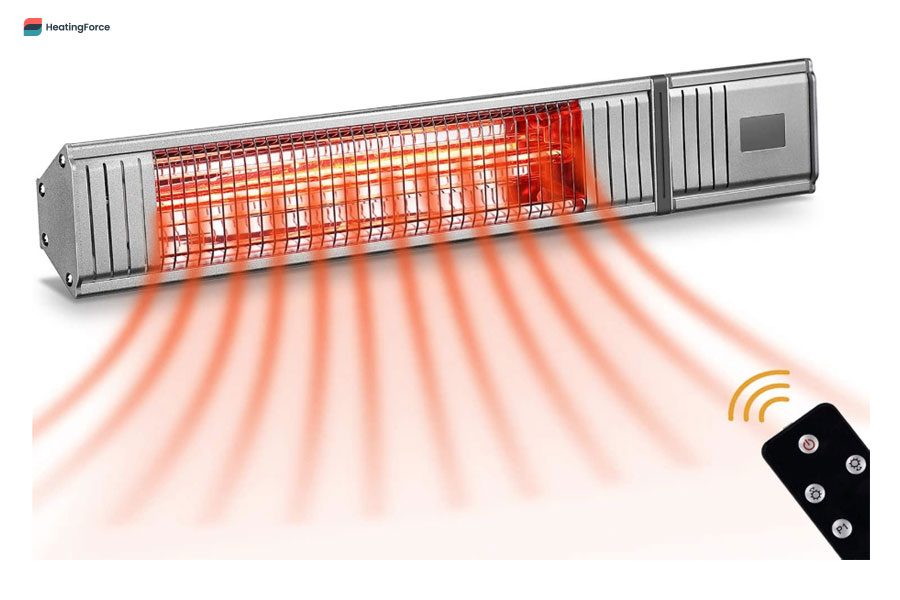
We really love the unique design of the Sundate 3,000W. Made with strong components, including an anodised extruded aluminum alloy housing, Sundate has put its money where its mouth is, offering a 30-day money-back guarantee. It has an IP65 rating, which means it is sealed against dust and is protected against water that is projected from a nozzle, meaning it is suitable for outside use.
The heat output of 2,000 W is laudable, but we found the lack of variable outputs to be a minor inconvenience. Of course, one way around this is to toggle it on and off as the need requires, although this makes it impractical for passive use.
Who should buy this infrared patio heater?
Anyone who likes a good guarantee should be enamoured by this offering from Sundate. Moreover, Sundate estimates you will save 30 to 40% when compared to traditional gas-powered patio heaters, which means you’ll be saving money in the long run. Additionally, anyone who’s a fan of easy installation (and, let’s face it, who isn’t?) will enjoy the refreshingly easy setup. The on/off rocker switch that comes included is also a welcomed addition, ensuring easy use.
A heater with such a strong output is probably best for larger rooms. A lack of variability means we would suggest not using this as a bedroom heater. However, if you have a patio, garden, barbecue area, outdoor lounge, balcony, or some other outdoor arrangement, Sundate is a good bet.
Pros of this patio heater:
- Long service life @ 5,500 to 6,000 hours
- Efficient
- 12-month guarantee
- 30-day money-back guarantee
- CE, GS, RoSH certified
- Dustproof and water-resistant
- Strong heat output at 3,000 W
Cons of this patio heater:
- Only one heat output
7. Blumfeldt Dark Wave Infrared Electric Patio Heater
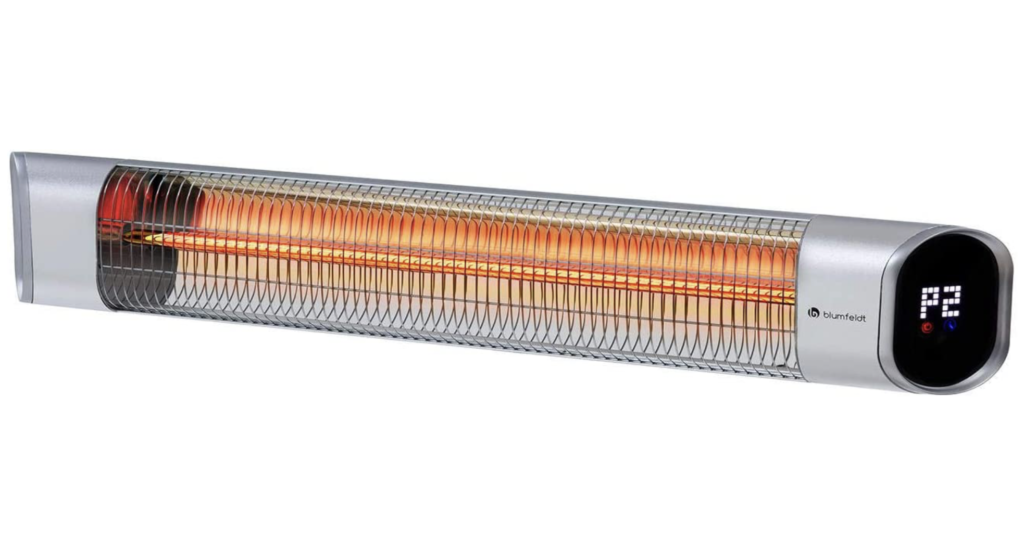
Whilst aesthetics are often overlooked by patio heater manufacturers, the Blumfedlt Dark Wave electric patio heater is an exquisitely sleek creation. As we opened the box, it stunned us with its elegant silver housing, gold-plated carbon tube, and aluminum reflector.
Once turned on, we noticed 2 things — the heat came on quickly (as it always does with infrared heaters) — and the glare was really unobtrusive. So, sorry romantics — don’t expect the Dark Wave to soothe you with that warm, cosy light. But that’s not really the heater’s purpose, is it.
Another thing that shocked us is the choice of 9(!) heat settings, which you can either control through 1 of the heater’s 2 touch panels, or via remote control.
Unlike most electric patio heaters that like to call themselves “waterproof” with a meagre IPX4 rating, this beauty is actually waterproof, being rated IP65.
Who should buy this infrared patio heater?
If you’re looking for a wall-mounted outdoor heating solution that’s as visually appealing as it is functional and powerful, the Blumfeldt is it.
It’s dead simple and durable too, so it should withstand many years’ worth of usage. It’s a shame there’s no guarantee, but hey, it’s a German-made product available at a fraction of the price as other comparable models.
Pros of this patio heater:
- Gentle, targeted heat beats the cold outdoor air
- Waterproof, at IP65
- Simple to set up and operate
- Low maintenance
Cons of this patio heater:
- Nothing obvious
8. KIASA – 1m500 W Ceiling Patio Heater (Infrared)
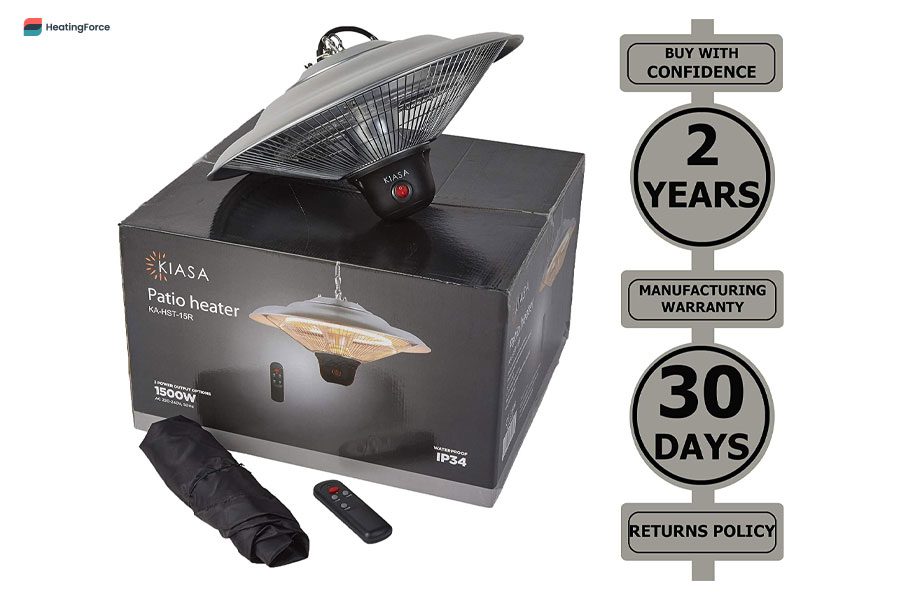
This 1,500W Ceiling Electric Patio Heater from KIASA is unlike anything else on this list — this outdoor patio heater doubles as a sort of lantern.
It features a remote control and uses a very efficient infrared heating mechanism and a special halogen tube. Additionally, we liked that KIASA has added 3 heat settings, which is especially useful when you consider that this heater isn’t designed to be portable.
It also has an IP34 rating, which means it’s protected against water splashes.
KIASA has also included a free cover, which is something that frequently seems to get overlooked (or deliberately ignored as a cost-cutting measure) by heater manufacturers. KIASA has also included 30-day “quibble-free returns”, so you can always send it back if it isn’t working to your satisfaction.
Who should buy this infrared patio heater?
Anyone who is looking for an electric patio heater above a dining table or in a conservatory will be delighted with KIASA’s design choice here. At 1,500 W, KIASA has decided to go with efficiency over face-melting heat. Additionally, its 2-year warranty and shelf life of 5 years or more will give you many nights of desirable warmth, offering a stable heat that is unmatched by gas-powered heaters.
Pros of this patio heater:
- Long service life @ 5,500 to 6,000 hours
- Efficient
- 12-month guarantee
- 2 year warranty
- 30-day money-back guarantee
- CE, GS, RoSH certified
- Dustproof and water-resistant
- Strong heat output at 3,000 W
Cons of this patio heater:
- Only one heat setting
9. Swan Al Fresco Column Electric Patio Heater
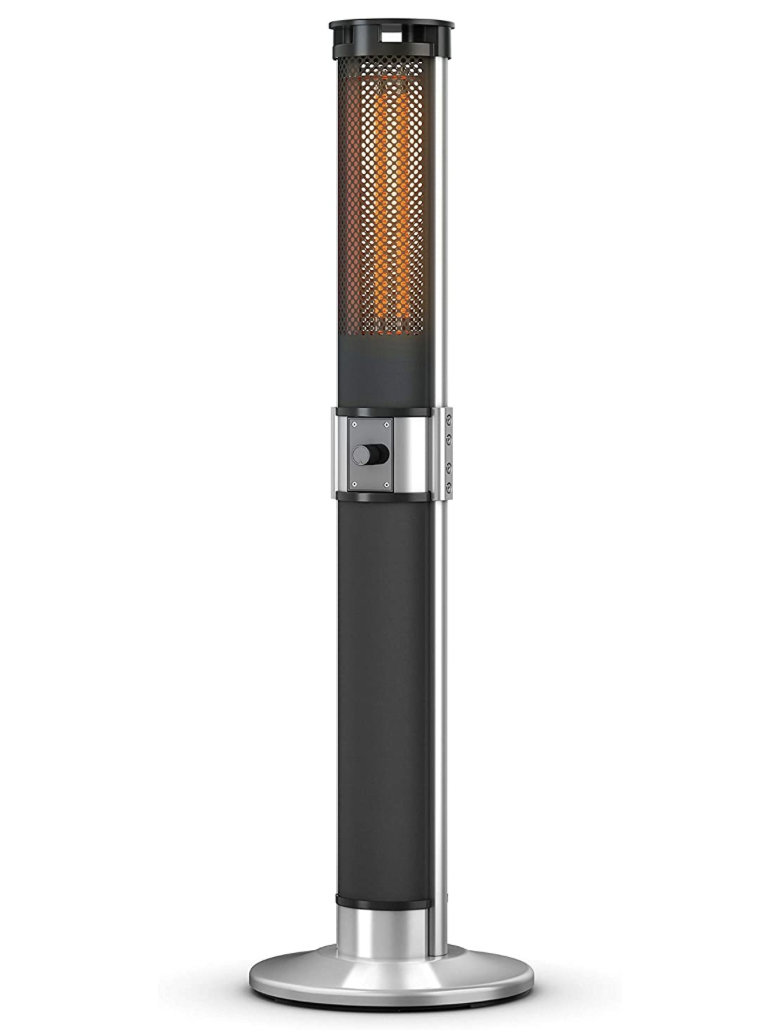
Here’s what we loved about this Swan Al Fresco electric patio heater — it radiates heat at just the right height to keep the chill away from your upper body whilst you’re sitting. Unlike some of the taller, freestanding heaters, or the ones you’d mount to the wall or ceiling, this configuration allows maximum efficiency; i.e., you get heat where you need it most.
As with most electric patio heaters we’ve tested, we noticed that this model cannot project heat very far. And that’s fine — it’s much better for the wallet and the environment to have milder heat closeby than getting strong heat from faraway.
We were happy to see that this electric patio heater comes with a tip-over switch — an essential safety feature for any freestanding heater.
Since the heater is rated IPX4, it’s also splash-resistant — meaning, it can theoretically withstand a drizzle; although we’d never operate any electrical device rated below IPX5 under wet conditions.
Who should buy this patio heater?
If you’re looking for a gentle, steady stream of warmth from your electric patio heater, this free standing model is an excellent option. Turn it on the max heat setting (2,000W), and enjoy those cool, early autumn or late spring evenings outdoors or on a veranda.
Like most electric patio heaters, the warmth you’ll experience is far from intense, but thanks to this heater’s portability and optimally positioned heating element, you can easily move the warmth as close to yourself as you like. This way, you can keep the cold away without relying on powerful — but wasteful — gas patio heaters.
Bear in mind, that if you’re looking for a patio heater to keep an entire party of guests warm outdoors, this heater won’t suffice. It’s far better suited for individual use.
Pros of this patio heater
- Direct, gentle heat
- Optimally situated heating element
- Helps conserve energy
- Highly portable, yet stable
- Tip-over safety switch
Cons of this patio heater
- Unsuitable for chilly weather
- Insufficient heat for large groups of people
- “Splash-proof” rating — best kept under an enclosure (such as a gazebo) in wet weather
10. Firefly Table-top Electric Patio Heater
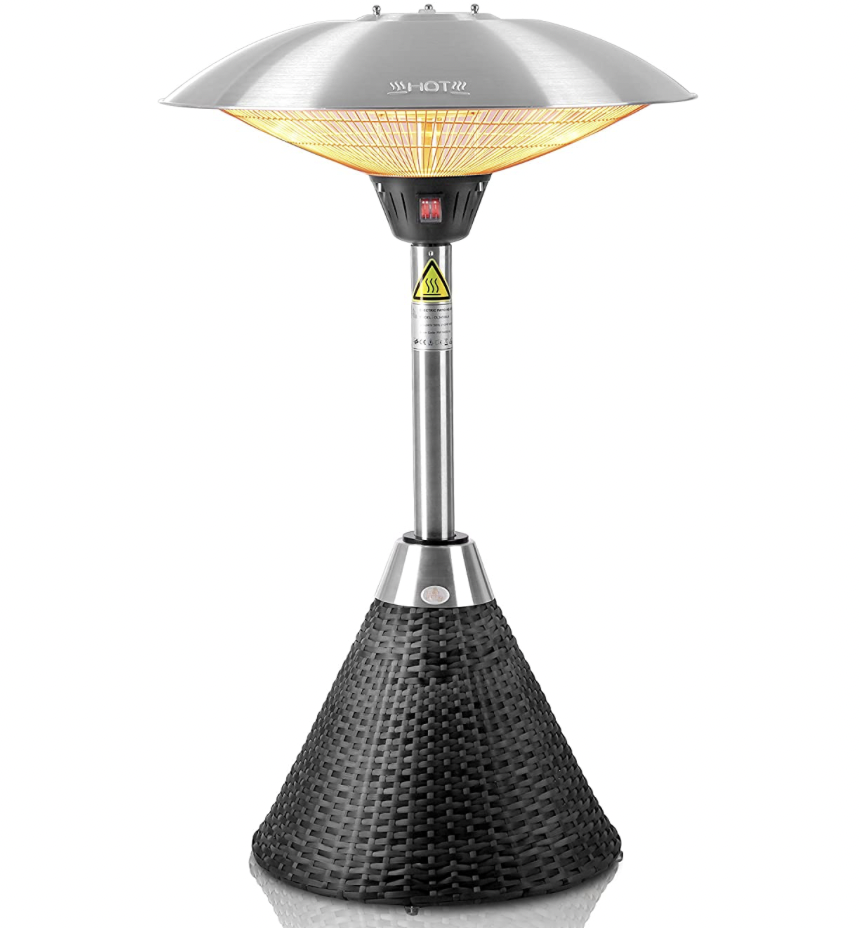
Finishing off our list of the best electric patio heaters in the UK is a rather unique item — a mushroom-style, table-top heater from Firefly.
The first thing we noticed when we received this heater is that it looks and feels sturdy. And although we haven’t got a rattan table here, the heater’s rattan’s base is certainly a nice match for any rattan patio furniture you may have.
In terms of heat, the highest setting (2,100W) proved sufficient in a gazebo on a cool, autumn evening. Like with most heaters of this type, we found that the heat was instant and consistent — something you don’t get from gas patio heaters. That said, you can’t count on this heater to keep you toasty on particularly chilly, windy days.
We found the assembly was rather simple, although we had to figure it out ourselves since the instructions were far from clear.
Who should buy this patio heater?
People with rattan patio furniture and good taste in outdoor decor!
Generally speaking, though, this electric patio heater is a fantastic choice if you need a tough, stable heater to keep you warm during an al fresco dinner or libations. (You’ll also find that the heating element doubles as a cosy table lamp — a feature that won this heater lots of points with our team).
Just remember — this heater is not built to keep the chill away during winter. Nor is it meant to replace layers of warm clothing when the temperatures plummet.
Pros of this patio heater
- Sturdy design
- Stable, rattan base
- Sufficient heat for cool/mild weather
- Serves as both a heater and table lamp
Cons of this patio heater
- Assembly instructions could be clearer
- Heat won’t suffice for cold weather
Electric Patio Heaters FAQs
Comparing the best electric patio heaters can be a nightmare. New products are constantly flooding the market, and there’s a flurry of advertisements loudly claiming one superlative or another. But thankfully, this fierce competition has lead to technological advances to where it’s very possible to find a highly efficient and effective electric patio heater.
Below, we address a few of the most frequently asked questions to help you make a more informed purchasing decision.
Is an electric patio heater any good?
Electric patio heaters are absolutely worth considering, especially if you’ve got a smaller space to heat. Of course, not all models are created equal, with some having very different heating elements as well as power and space requirements. But generally, this is a class of patio heater which has seen many improvements over the years, allowing them to produce more heat with less energy draw, at lower price points.
What’s the difference between electric and gas patio heaters?
While we’ve made several enthusiastic recommendations for the best electric patio heaters in this article, we can’t in good conscience say that these will be the absolute best pick for every possible situation. In order to pick the right tool for the job, it’s important to understand the main differences between gas and electric heaters.
In truth, there are actually two main types of gas heaters (propane, natural gas) and electric heaters (halogen, ceramic):
Gas patio heaters overview
Gas-powered patio heaters differ in their fuel sources, but mostly produce heat the same way. Both types warm up instantly and disperse their heat in a 360° area, though strong winds will disrupt the evenness of the heating pattern.
Natural gas heaters require professional installation, as they must be hooked into your home’s gas supply to function. Propane heaters, on the other hand, can be moved around with relative ease since their fuel source is conveniently contained within propane tanks. Natural gas is cleaner-burning, while propane is more powerful.
Both types of gas heaters include carbon monoxide as a byproduct, and should be strictly used in well-ventilated or outdoor scenarios.
Electric patio heaters overview
Similar to natural gas heaters, electric patio heaters tend to be stationary, as they require proximity to the home’s electrical mains. They tend to produce uni-directional (though omni-directional models are available) infrared heat that is not effected by the wind blowing, though it may take a moment to reach optimal temperatures. The lack of open flame also poses far less of a fire hazard.
Without getting too technical, halogen and ceramic patio heaters largely differ in the type of heat they produce. Ceramic heat comes from the invisible far end of the infrared spectrum, while halogen’s shorter, higher-energy wavelengths are visible as a warm red-orange glow.
Ceramic feels less hot at first, but builds up for a more comforting, gentler warmth over time.
Halogen’s effects are more immediate, and work a treat to keep frosty, blustery weather at bay. Halogen patio heaters are also known as tungsten heaters, quartz heaters, and low-glare heaters.
Propane vs natural gas vs halogen vs ceramic patio heaters – Which outdoor heater is best for me?
So, how do you pick the best patio heater for your needs? Here are some pros and cons of each:
- Halogen patio heaters radiate directional, high-energy heat well-suited to outdoor patios. Thus, they do a good job of taking the chill out of the air quickly, and can provide a cosy ambiance with their warm glow. The downside is that they’re less efficient than natural gas over the long-term. That said, they’re the cheapest upfront, don’t require professional installation, and need only occasional maintenance — to replace the heating bulb.
- Ceramic patio heaters are more efficient than halogen patio heaters, but are decidedly a “slower” burn in terms of heating up your surroundings. Thus, they’re best deployed in garages, workshops, or enclosed patios with some ability to trap the heat in, rather than being used as an outdoor heater. Ceramic patio heaters provide the most comfortable, natural-feeling heat that won’t dry out the air or agitate allergies.
- Propane patio heaters are the most portable and powerful, but their highly flammable fuel source requires greater care to handle safely. Smaller propane patio heaters are an amazing choice for caravans or hosting events, as they can be easily deployed without expert service or proximity to a gas line. There is a large variety of propane patio heaters to fit any space, at a range of price points.
- Natural gas patio heaters are the more eco-friendly choice, as natural gas burns extremely cleanly and efficiently. However, they’re the most expensive to purchase upfront, and require both professional installation and occasional maintenance to prevent gas leaks and carbon monoxide build-up. Kept in good condition, however, natural gas heaters are both safe and reliable. This is especially true since you can run them to stay warm even during a blackout.
How much power do I need to heat my patio?
A simple way to gauge if an electric patio heater is suitable is to compare its BTU output to the size of your patio. There’s no simple, linear formula that works for every patio area, but here are a few useful guideposts:
- 100-150 sq. ft. – 5,000 BTU
- 400-450 sq. ft. – 10,000 BTU
- 700-1,000 sq. ft. – 18,000 BTU
- 1,500-2,000 sq. ft. – 30,000 BTU
As you can see, the larger your patio, the higher heat required to adequately fill the space. Because of the diminishing returns on heating large spaces with a single, high-powered heater, you might consider doubling or tripling up with multiple smaller heaters, instead.
How to care for your electric patio heater: lights and accessories
There are many affordable electric patio heaters that can withstand all-weather exposure. That said, a bit of maintenance and care will go a long way! Here are a few tips to keep your patio heater running its best:
- Halogen heaters require new bulbs every 3-5000 hours. If you suspect your patio heater isn’t producing the heat it once was, realize the lights have dimmed, or notice higher power bills, consider the age of your bulb. They’re cheap to buy, and easy to replace yourself – just try not to touch the bulb with your bare, oily skin.
- Remove the reflectors and bulbs before major storms. If there’s miserable weather on the horizon, unscrewing the heat reflector and bulb from your electric patio heater will prevent physical damage from reducing its efficacy. This is a bit of an annoyance for a device that promises to be maintenance-free, so you only really need to do this when gale-force winds are afoot. Even then, it’s mostly a precaution, as most electric patio heaters are extremely robust and durable.
- Clean your unit often. Similar to the previous tip, any damage, debris, or dirt will lower the efficiency of your patio heater. You can wipe stainless steel down with a damp cloth, or wash powder-coated heaters with a bit of soap and water, to remove any dust or dirt that may collect over time (just be sure to unplug it first!)
- Protect your heater with a cover. There are excellent patio heater covers out there than can shield your device from possible damage caused by inclement weather.
What are some safety concerns I should consider with a patio heater?
It’s vital that you monitor your heater’s performance in case it has any issues, electric or mechanical.
Although rare, there is a chance that your heater might be defective and spark out. In such a case, it is important to keep tabs on performance. Manufacturers are generally very good about replacing defective heaters, which is often covered by your warranty. However, you must also look after the well-being of both your family and property, as anytime you use an electric appliance there is a risk of fire.
Also, keep in mind that high-powered electric patio heaters will increase the load on your fuse box. The models you buy in-store are almost certainly going to be rated for safe household use. But, if you’re going for a more powerful solution, double-check that the numbers match up to prevent blackouts or fires.
Other things that are common sense but are worth reiterating is ensuring that you don’t get too close to a heater or put objects too close it. Putting flammable objects (tables, chairs, or other furniture) within close proximity to a heater is a fire risk. Ensure you have a fire alarm and fire extinguisher on hand in the unlikely event of a fire — even if you place your heater in a garden.
Conclusion: Choosing a patio heater
The best electric patio heaters are great for more than just patios. Indeed, quality electric patio heaters (unlike gas-powered patio heaters) are well-suited for indoor use. In short, electric patio heaters cost less to run, are safer, and offer more flexibility than their gas-fired peers.
We’d suggest writing down your budget, the place where you’ll use your heater, and whether you prefer a freestanding or wall-mounted model. It’s also good to consider the risk of fire if the heater will be located near any furniture. Of course, there is also the design to consider, but that’s something that only you will be able to answer.
Furthermore, we strongly suggest reading the specs and manufacturer’s guide. Most manufacturers will include all the pertinent information (such as price, power, features, materials, physical appearance, electric wattage, warranty, and any guarantees).
Finally, do your research and read customer reviews to get a broad sense of a given heater’s strengths and weaknesses. Then you can choose which patio heater is the best for you, by knowing that it comes with a strong warranty, along with the features you want and need, be it for an outdoor area like a garden, or somewhere enclosed.
Is there anything that we missed? Have you used any of the heaters in this guide, or any others? If you have, or there’s a question you’d like to ask, please leave us a comment below!